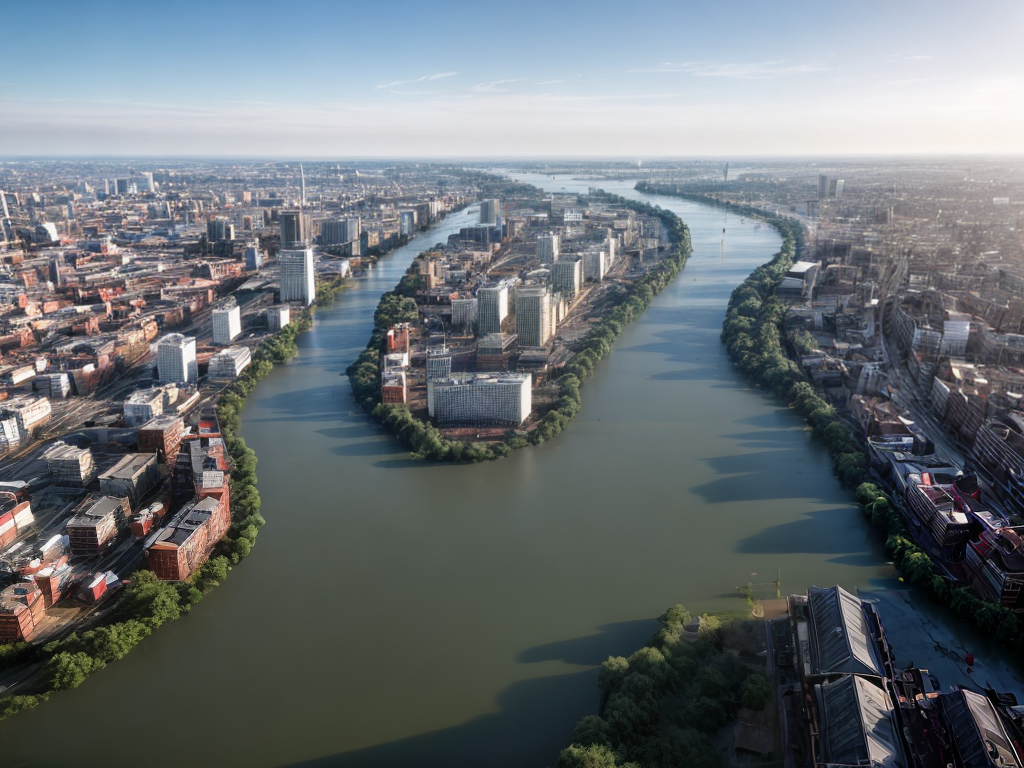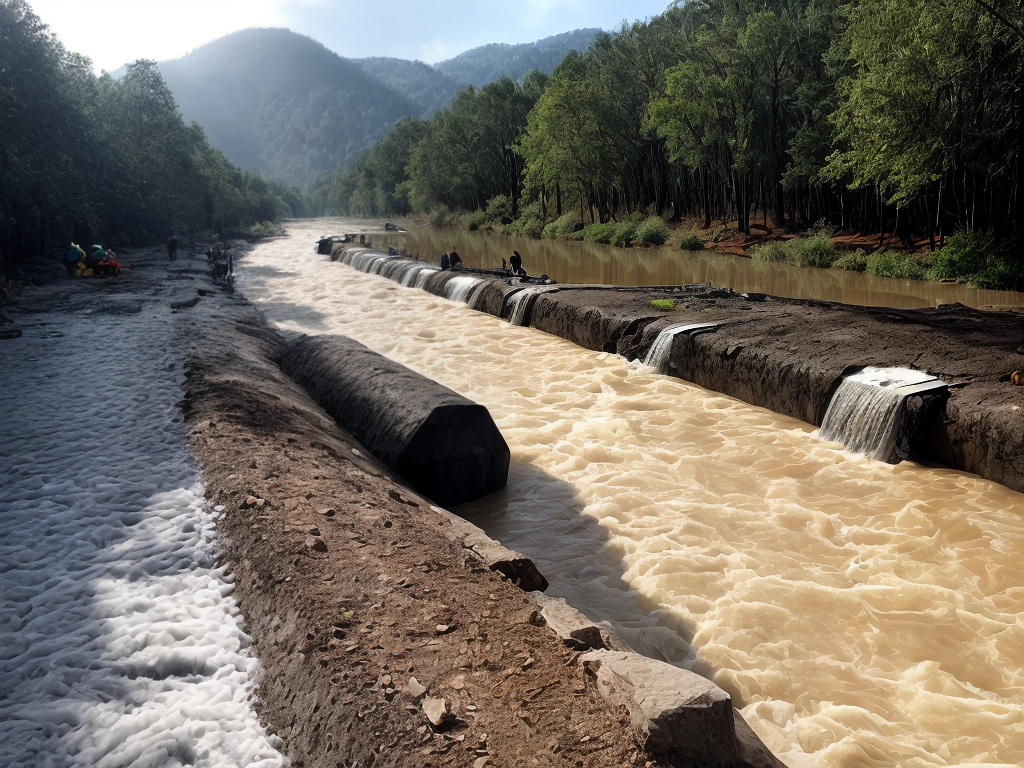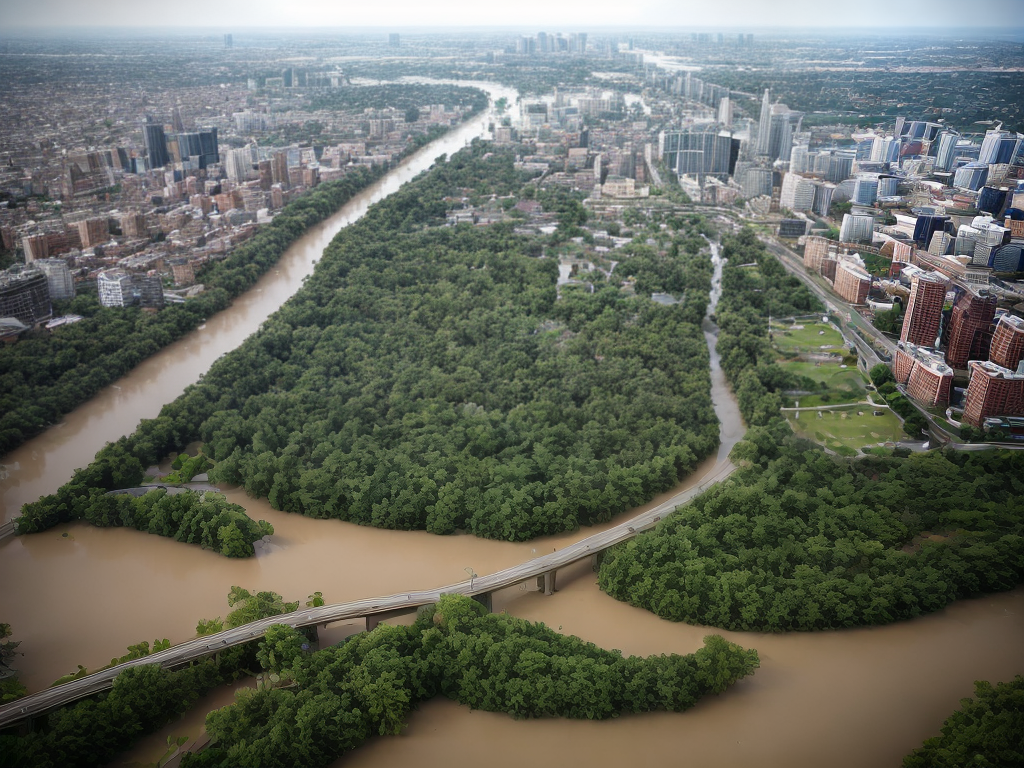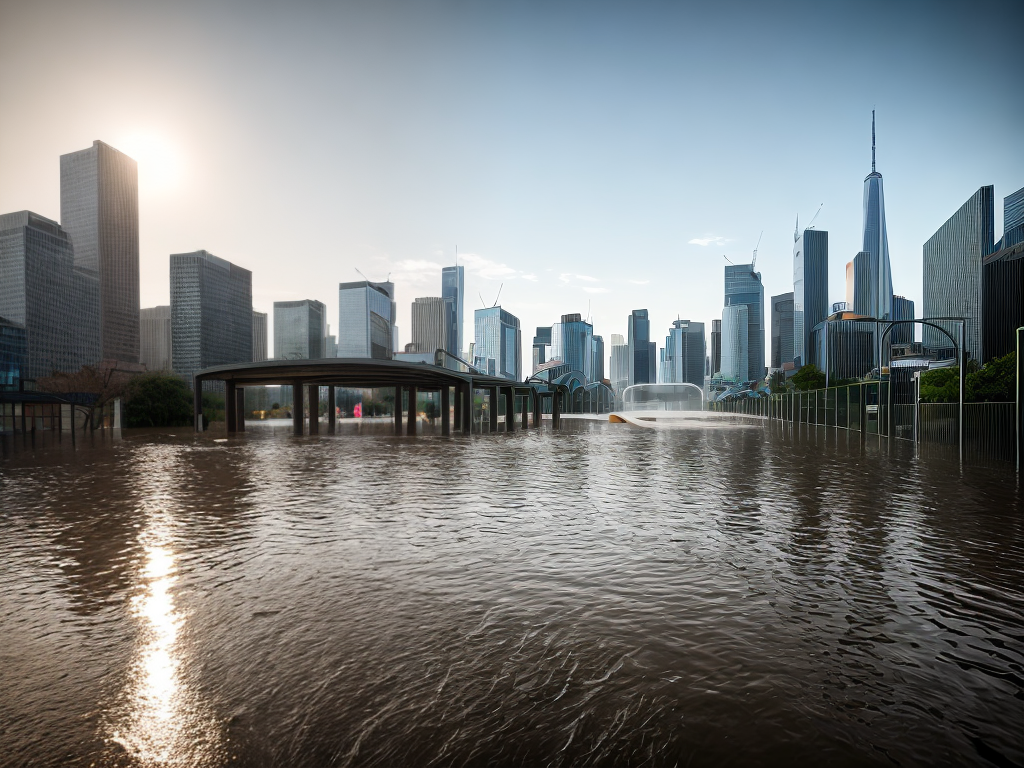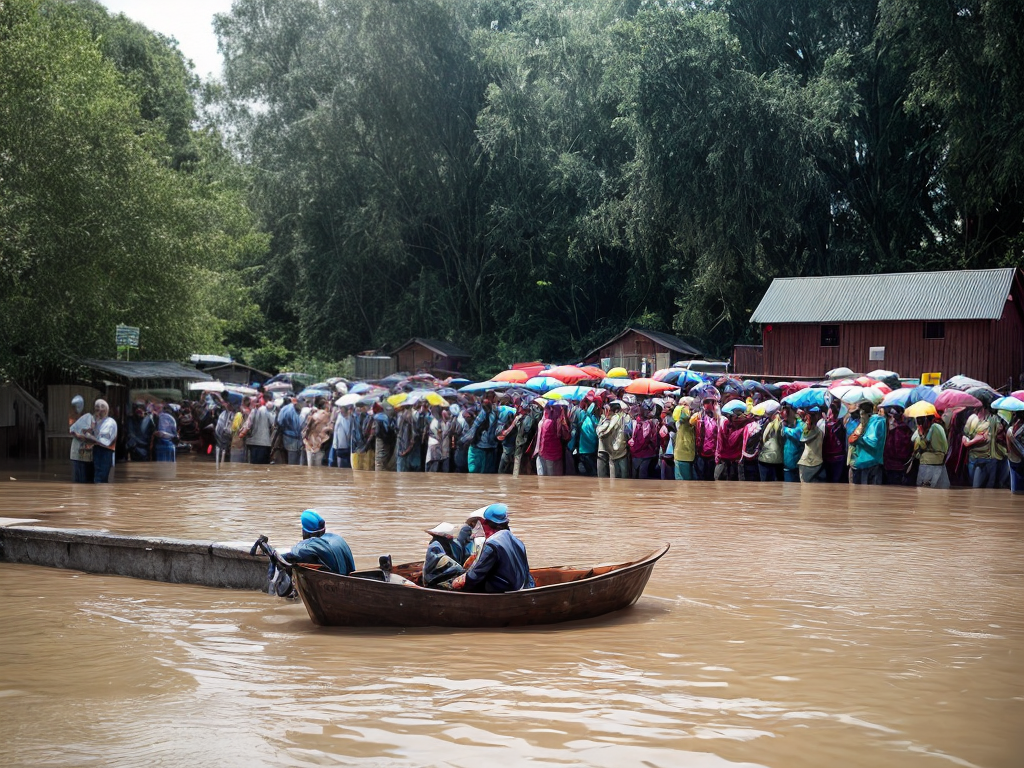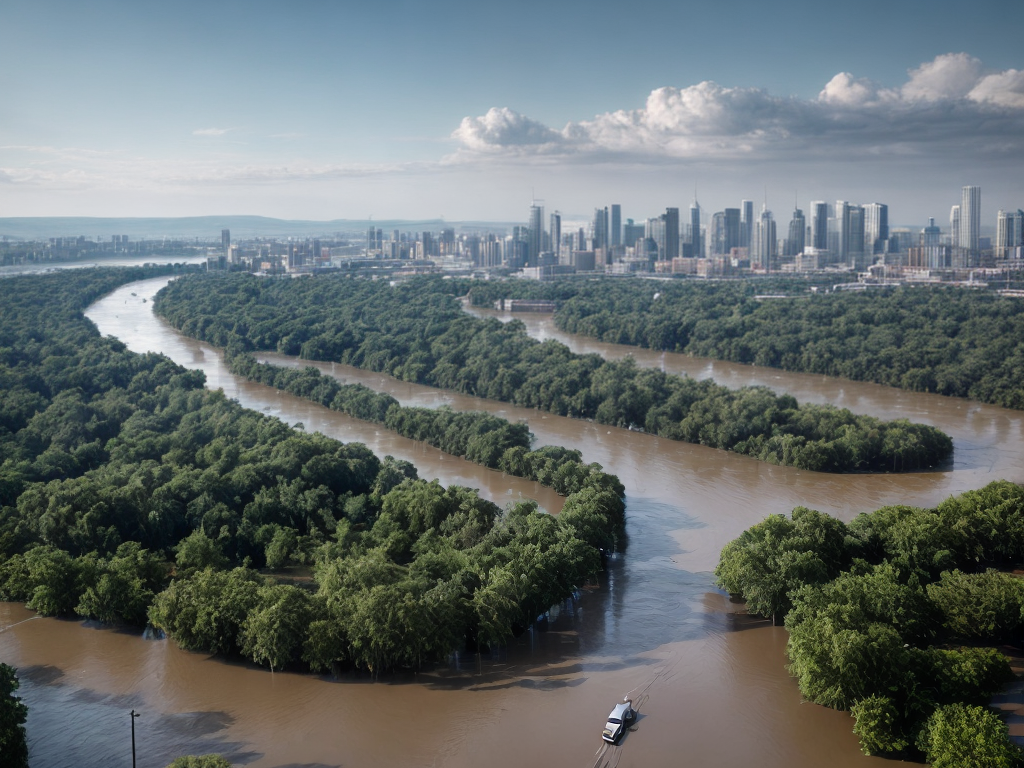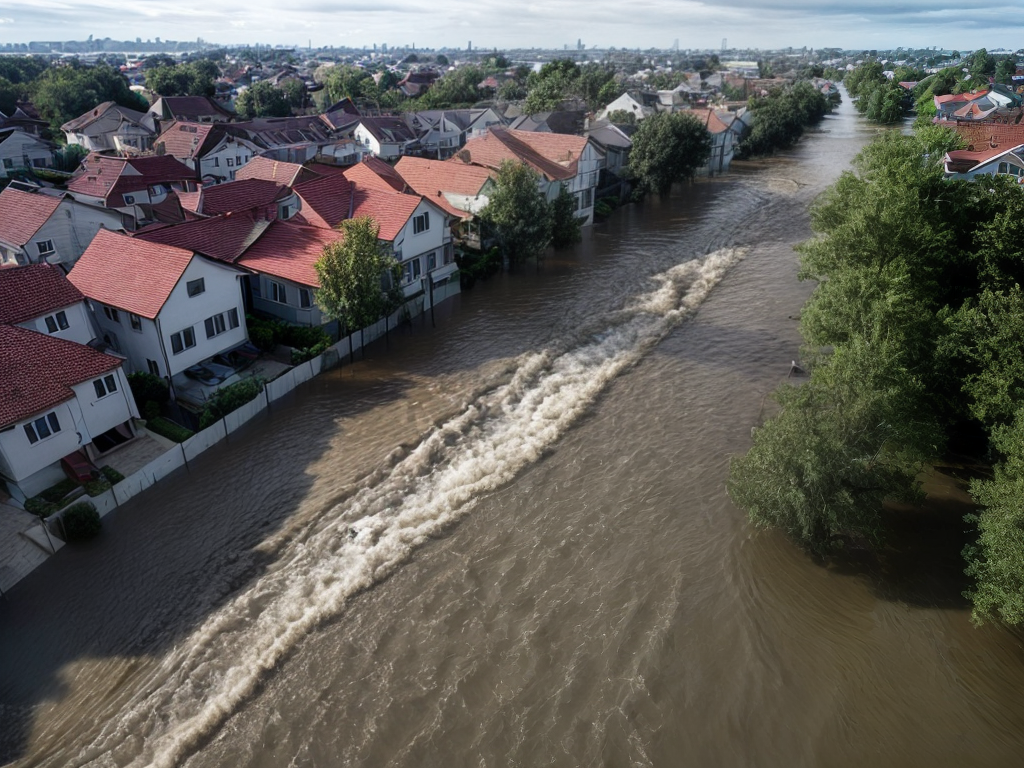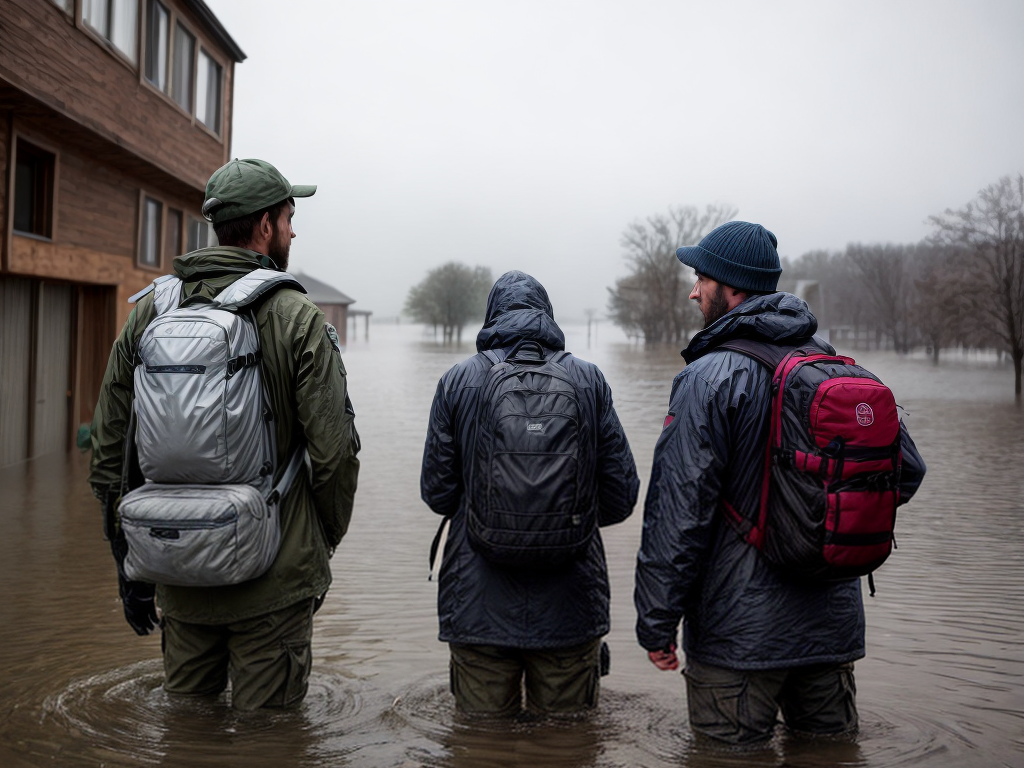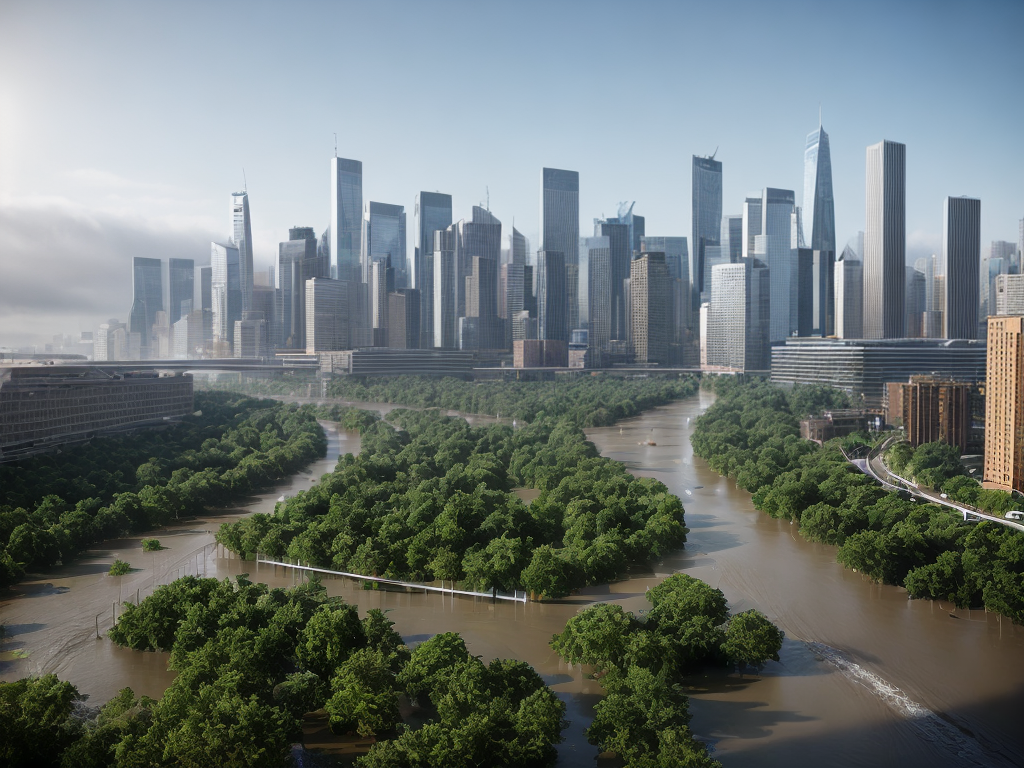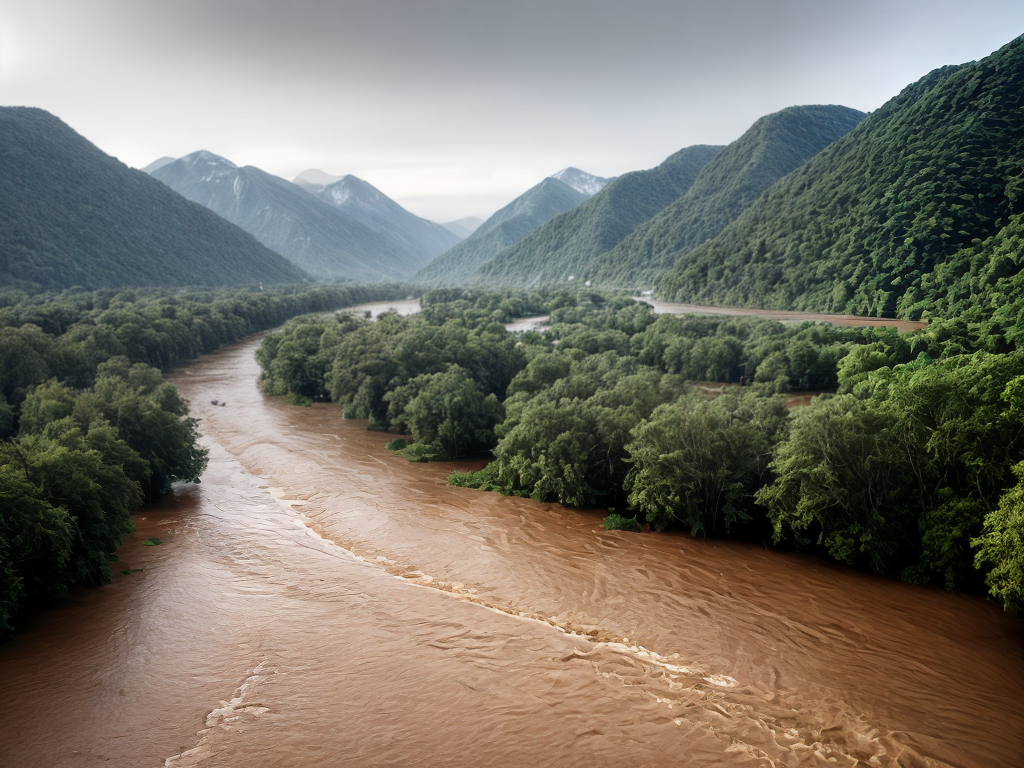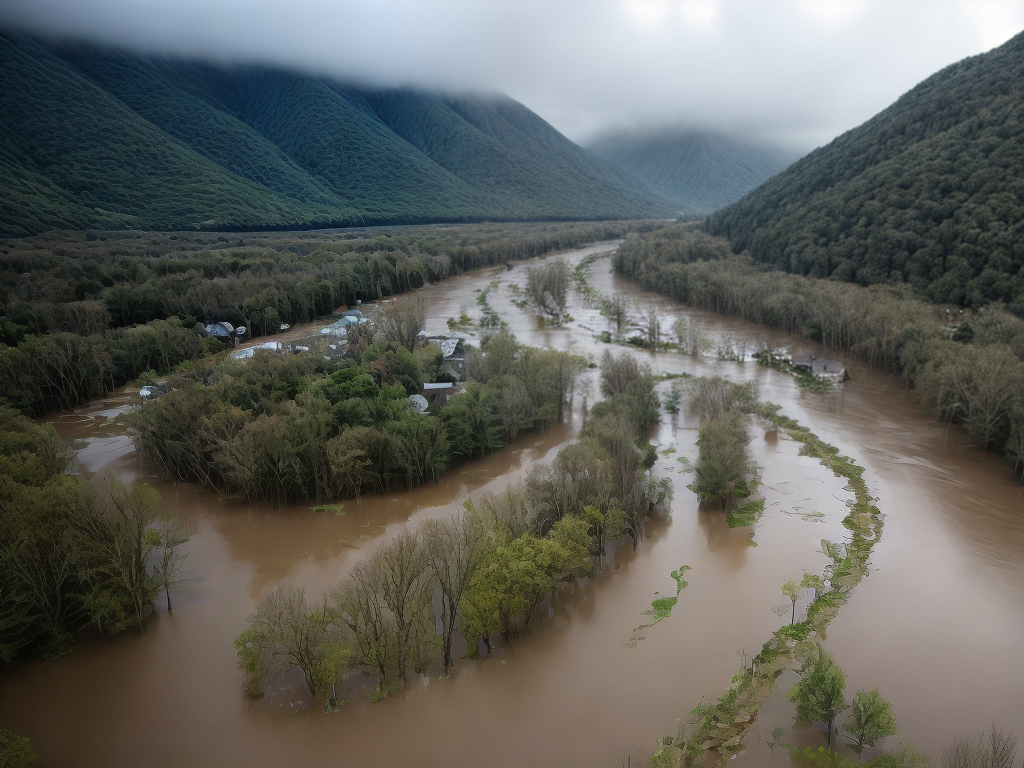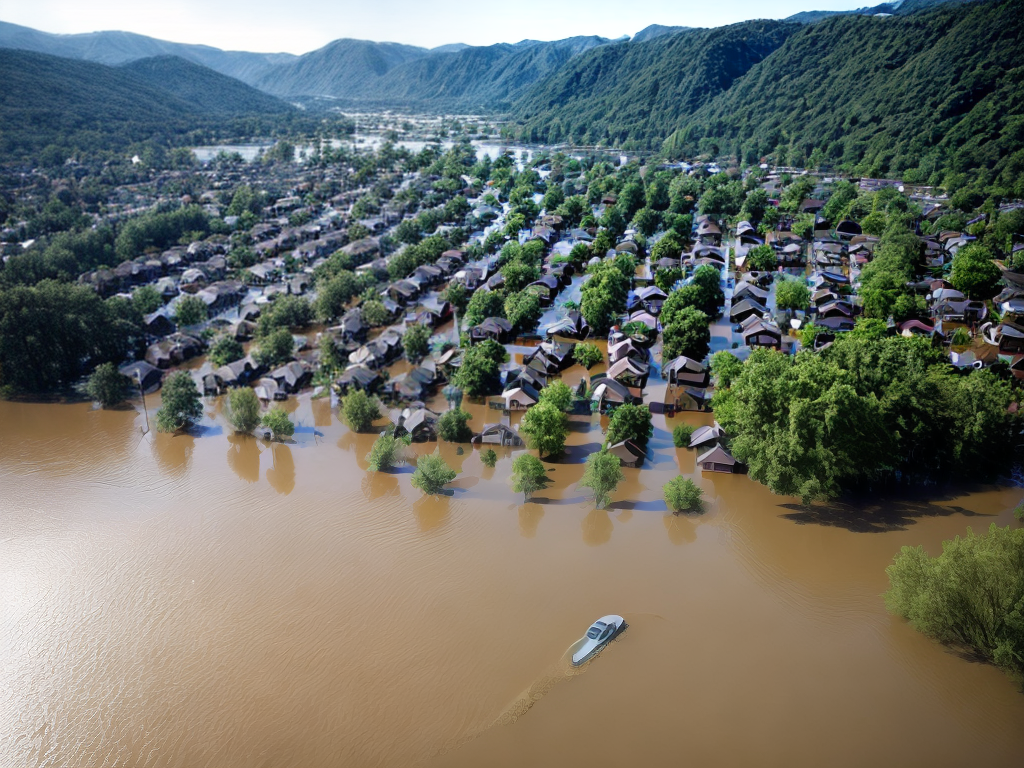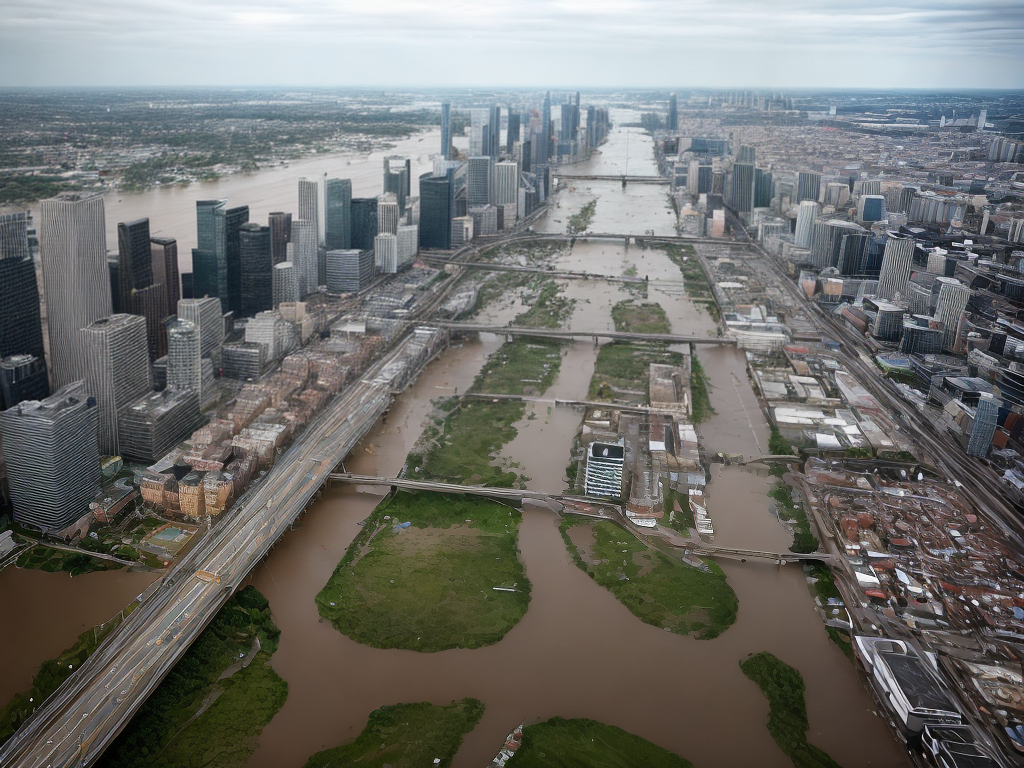As we navigate the uncertain waters of climate change, it becomes increasingly important to explore innovative flood control strategies. Take, for instance, the case of a coastal city that has experienced a rise in sea levels and an increase in severe storms. This city has implemented a combination of green infrastructure, such as permeable pavements, and wetland restoration to absorb excess water and reduce flood risk. However, these strategies are just the tip of the iceberg when it comes to the range of innovative approaches that can be employed. In this discussion, we will explore a variety of cutting-edge flood control measures that hold promise in the face of climate change, leaving you eager to discover how we can better protect our communities and adapt to this evolving threat.
Key Takeaways
- Green infrastructure and wetland restoration are effective strategies for flood control and climate change adaptation.
- Technology plays a crucial role in wetland restoration and flood control, enabling advanced mapping, remote sensing, real-time monitoring, and data-driven decision-making.
- Adaptive infrastructure design, real-time data analysis, and elevated buildings contribute to more resilient and responsive flood control systems.
- Resilient urban planning, rainwater harvesting, and sustainable water management are essential components of innovative flood control strategies in the face of climate change.
Green Infrastructure
Green infrastructure plays a crucial role in our efforts to mitigate flood risks and adapt to climate change. As we strive for innovative solutions, two key components of green infrastructure that warrant attention are green roofs and permeable pavement.
Green roofs are an innovative and sustainable approach to managing stormwater runoff. By covering rooftops with vegetation, these roofs absorb rainwater, reducing the amount of water that flows into our storm drains and ultimately preventing flooding. Not only do green roofs help to control flooding, but they also provide additional benefits such as improving air quality, reducing energy consumption, and creating green spaces in urban environments.
Another important element of green infrastructure is permeable pavement. Unlike traditional impermeable surfaces like concrete, permeable pavement allows water to infiltrate into the ground. This helps to reduce the volume of stormwater runoff and alleviate the strain on our drainage systems during heavy rainfall events. Additionally, permeable pavement filters pollutants and contaminants, improving water quality and protecting our ecosystems.
Wetland Restoration
Wetlands offer numerous benefits and play a crucial role in flood mitigation. To effectively restore wetlands, we need to employ various techniques that promote their revival and resilience. In this discussion, we will explore the benefits of wetlands, their role in flood control, and the techniques used in wetland restoration.
Benefits of Wetlands
Restoring wetlands offers numerous benefits in the face of climate change, providing natural flood control and enhancing ecosystem resilience. Wetland conservation plays a crucial role in mitigating the impacts of flooding and climate change. Here are five key benefits of wetlands:
- Flood mitigation: Wetlands act as natural sponges, absorbing excess water during heavy rainfall and reducing the risk of floods.
- Water purification: Wetlands filter and cleanse water, improving its quality and ensuring a sustainable supply for communities.
- Biodiversity support: Wetlands provide habitats for a diverse range of plant and animal species, promoting biodiversity and preserving ecological balance.
- Carbon sequestration: Wetlands store and absorb significant amounts of carbon dioxide, helping to reduce greenhouse gas emissions and combat climate change.
- Recreation and tourism: Wetlands offer opportunities for recreational activities such as birdwatching, boating, and hiking, attracting tourists and boosting local economies.
Role in Flood Mitigation
By restoring wetlands, we can effectively mitigate the impacts of flooding and climate change. Wetlands play a crucial role in flood mitigation by acting as natural buffers, absorbing excess water during heavy rainfall and reducing the risk of downstream flooding. However, to maximize their potential, we need to incorporate innovative technologies and encourage community participation.
The role of technology is essential in wetland restoration for flood control. Advanced mapping tools and remote sensing technologies can help identify suitable areas for wetland restoration, ensuring the most effective flood mitigation outcomes. Additionally, we can use drones and satellite imagery to monitor and assess the health of restored wetlands, allowing us to make data-driven decisions for their maintenance and improvement.
Community participation is equally important. Engaging local communities in the restoration process fosters a sense of ownership and responsibility. By involving residents, we can enhance the effectiveness and sustainability of wetland restoration projects. Furthermore, community members can contribute valuable knowledge and insights, ensuring that restoration efforts align with their needs and priorities.
Wetland Restoration Techniques
To effectively restore wetlands for flood control, we must implement various techniques that enhance their functionality and resilience. Wetland restoration methods are crucial for wetland conservation and play a vital role in mitigating floods caused by climate change. Here are five innovative techniques that can be used:
- Hydrologic restoration: This method involves restoring the natural water flow patterns in wetlands, allowing them to function as natural floodplains.
- Vegetation management: By planting native vegetation and removing invasive plants, we can improve wetland resilience and enhance their flood control capabilities.
- Channel stabilization: This technique focuses on stabilizing channels within wetlands to prevent erosion and maintain proper water flow.
- Sediment management: Proper management of sediment deposition in wetlands can help maintain their capacity to absorb floodwaters.
- Adaptive management: This approach involves continually assessing and adjusting restoration strategies based on monitoring and feedback, ensuring the long-term success of wetland restoration efforts.
Flood Sensors
In order to monitor and respond to flood events more effectively, implementing flood sensors is essential. Flood sensors, equipped with smart technology, enable remote monitoring of water levels in real-time. This innovation allows for early detection of rising water levels, providing timely warnings and improving emergency response efforts.
To help you better understand the benefits of flood sensors, let’s take a look at the following table:
| Flood Sensor Features | Benefits |
|---|---|
| Real-time monitoring | Allows for immediate response to changing water levels |
| Remote accessibility | Enables monitoring from any location, increasing efficiency |
| Early warning system | Provides timely alerts to residents and authorities, reducing damage and potential loss of life |
| Data collection | Helps analyze flood patterns and improve flood control strategies |
| Integration with other systems | Enables integration with existing infrastructure, enhancing overall flood management capabilities |
Smart Infrastructure
When it comes to flood control, smart infrastructure plays a crucial role. Sensor-based monitoring allows us to gather real-time data on water levels, rainfall, and other relevant factors. This data can then be used to design adaptive infrastructure that can respond and adjust to changing conditions, ensuring more effective flood control strategies.
Sensor-Based Monitoring
We implemented sensor-based monitoring as a key strategy to enhance flood control in the face of climate change. By integrating smart irrigation systems and leveraging remote sensing technology, we have revolutionized the way we monitor and manage flood-prone areas. Here are five ways sensor-based monitoring has transformed flood control:
- Real-time data collection: Sensors provide continuous monitoring of water levels, rainfall, and soil moisture, allowing us to quickly respond to changing conditions.
- Early warning systems: With the help of sensors, we can detect potential flood risks and issue timely alerts to residents and authorities, minimizing damage and ensuring safety.
- Adaptive infrastructure: Sensor data informs the design and maintenance of flood control infrastructure, enabling us to create more resilient and responsive systems.
- Improved water management: By analyzing sensor data, we can optimize water usage and minimize wastage, leading to more efficient and sustainable irrigation practices.
- Enhanced decision-making: Sensor-based monitoring provides valuable insights that inform strategic planning, resource allocation, and policy decisions, enabling us to make informed choices in managing flood control.
Adaptive Infrastructure Design
Our approach to flood control includes the implementation of adaptive infrastructure design, specifically focusing on smart infrastructure solutions. Adaptive infrastructure planning is crucial in the face of climate change, as it allows for the development of resilient systems that can withstand the impacts of extreme weather events. By integrating climate resilient design principles into our infrastructure projects, we aim to create structures that are not only capable of withstanding flooding, but also adaptable to changing conditions. Smart infrastructure solutions play a key role in this approach, utilizing advanced technologies such as sensors, data analytics, and real-time monitoring to improve the effectiveness of flood control measures. These innovative solutions enable us to gather and analyze data in real-time, allowing for quick response and informed decision-making. Through adaptive infrastructure design, we can build a more resilient and sustainable future.
Real-Time Data Analysis
Implementing adaptive infrastructure design allows us to harness the power of real-time data analysis in smart infrastructure solutions. By leveraging real-time data visualization and predictive analytics, we can revolutionize flood control strategies in the face of climate change. Here are five ways real-time data analysis can drive innovation in flood control:
- Early warning systems: Real-time data analysis enables us to detect changes in water levels and weather patterns, providing early warnings for potential floods.
- Dynamic flood modeling: By continuously analyzing real-time data, we can create dynamic flood models that adapt to changing conditions and accurately predict flood risks.
- Optimal resource allocation: Real-time data analysis helps us allocate resources efficiently by identifying areas most prone to flooding and prioritizing preventive measures.
- Emergency response optimization: With real-time data, we can optimize emergency response efforts by monitoring flood conditions, predicting impacts, and coordinating rescue operations.
- Continuous monitoring and adaptation: Real-time data analysis allows for continuous monitoring of flood control measures, enabling timely adjustments and improvements.
Through real-time data analysis, we can enhance the effectiveness and efficiency of flood control strategies, creating a safer and more resilient future.
Elevated Buildings
To effectively address the increasing risks of flooding due to climate change, one potential solution is the construction of elevated buildings. In this era of innovation and sustainability, elevated design and flood-resistant architecture offer promising solutions to counter the challenges posed by rising sea levels and extreme weather events.
Elevated buildings are designed to mitigate flood risks by raising the habitable space above the potential flood level. By elevating structures, we not only protect valuable assets but also ensure the safety and well-being of the people who reside or work in these buildings. These elevated designs not only provide a protective barrier against floodwaters but also offer a space for the community to gather during emergencies.
Flood-resistant architecture is another key aspect of building in flood-prone areas. It involves using materials and designs that can withstand the impact of flooding and minimize damage. For instance, using flood-resistant materials such as concrete, steel, or composite materials can help prevent structural damage caused by water infiltration. Additionally, incorporating features like flood-resistant doors and windows, waterproof insulation, and raised electrical systems can further enhance the resilience of these buildings.
Moreover, elevated buildings can also serve as a catalyst for urban development. By constructing elevated structures, we can optimize land use and create additional space for various purposes, such as parking, recreational areas, or green spaces. This not only adds value to the community but also promotes sustainable and resilient urban planning.
Resilient Urban Planning
Resilient urban planning plays a crucial role in safeguarding communities against the impacts of climate change and ensuring sustainable development. In order to create resilient cities that can withstand the challenges posed by climate change, innovative strategies need to be implemented. Here are five key ideas for resilient urban planning:
-
Integrating green infrastructure: Incorporating green spaces, such as parks and gardens, into urban development plans not only enhances the aesthetic appeal of cities, but also improves their resilience. Green infrastructure helps mitigate the impacts of climate change by reducing urban heat island effects, improving air quality, and absorbing excess rainfall.
-
Promoting mixed-use developments: Encouraging the integration of residential, commercial, and recreational spaces within close proximity fosters walkability and reduces the need for long commutes. This not only reduces carbon emissions but also enhances community resilience by creating vibrant and inclusive neighborhoods.
-
Designing resilient infrastructure: Developing infrastructure that can adapt to changing climate conditions is essential for urban resilience. This includes investing in robust water management systems, designing buildings that can withstand extreme weather events, and implementing smart technologies to monitor and manage urban systems.
-
Prioritizing social equity: Resilient urban planning should prioritize social equity to ensure that vulnerable communities are not disproportionately affected by climate change impacts. This involves providing affordable housing options, improving access to amenities and services, and incorporating social and cultural factors into urban development plans.
-
Engaging the community: Effective resilient urban planning requires active community engagement and participation. By involving residents, businesses, and other stakeholders in decision-making processes, cities can tap into local knowledge and leverage the collective efforts of the community to develop innovative solutions.
Rainwater Harvesting
When it comes to rainwater harvesting, there are several benefits to consider. First, it helps to reduce the strain on existing water sources by providing an alternative supply. Additionally, rainwater harvesting promotes sustainable water management practices and can help mitigate the impact of floods by capturing and storing excess rainwater. However, implementing rainwater harvesting systems can also present challenges such as the need for proper infrastructure and maintenance, as well as potential regulatory and cost considerations.
Benefits of Rainwater Harvesting
Rainwater harvesting offers numerous benefits, making it an effective strategy for flood control in the face of climate change. Here are some key advantages of rainwater collection and its role in water conservation:
- Sustainable water supply: Rainwater harvesting provides an additional source of water, reducing reliance on traditional sources like rivers or wells. This ensures a continuous water supply, even during droughts or water shortages.
- Flood prevention: By collecting rainwater, we can reduce the volume of water flowing into rivers and stormwater drains, mitigating the risk of flooding.
- Soil moisture retention: Rainwater can be stored and used for irrigation, helping to maintain soil moisture levels and promoting healthy plant growth.
- Reduced strain on infrastructure: By utilizing rainwater, we can decrease the demand on water treatment plants and distribution systems, extending their lifespan and reducing maintenance costs.
- Water quality improvement: Rainwater is naturally pure and free from contaminants, making it suitable for various non-potable uses, such as toilet flushing or car washing.
Implementation Challenges
While rainwater harvesting offers numerous benefits for flood control, there are several implementation challenges that need to be addressed. One key challenge is the need for community involvement. Implementing rainwater harvesting systems requires active participation from local residents and community organizations. This can be achieved through awareness campaigns and educational programs that highlight the importance of rainwater harvesting in flood control. Another challenge is the lack of proper infrastructure and resources to support rainwater harvesting initiatives. This includes the installation of rainwater collection systems, storage tanks, and treatment facilities. Additionally, there may be regulatory and policy barriers that need to be overcome to encourage widespread adoption of rainwater harvesting practices. Overcoming these implementation challenges will require collaboration between government agencies, communities, and stakeholders to develop innovative solutions that ensure the successful implementation of rainwater harvesting for flood control.
Sustainable Water Management
To effectively manage water resources in the face of climate change, how can we implement sustainable practices such as rainwater harvesting? Rainwater harvesting is a crucial strategy for sustainable water conservation and efficient water resource management. Here are five innovative ideas to consider:
- Implementing rain barrels and cisterns to collect and store rainwater for later use.
- Designing green roofs and permeable pavements that allow rainwater to be absorbed into the ground.
- Developing decentralized rainwater harvesting systems to reduce pressure on centralized water infrastructure.
- Promoting the use of rain gardens and bioswales to capture and filter rainwater, replenishing groundwater supplies.
- Educating communities about the benefits of rainwater harvesting and providing incentives for its adoption.
Coastal Barrier Systems
One effective strategy for managing the increased risk of coastal flooding due to climate change is the implementation of coastal barrier systems. These systems, which encompass various coastal barrier designs and flood control measures, are crucial in protecting coastal communities from the devastating impacts of rising sea levels and extreme weather events.
Coastal barrier design plays a critical role in the effectiveness of these systems. Innovative approaches, such as the use of modular barriers and artificial reefs, are being explored to provide coastal protection while also minimizing ecological and environmental impacts. These designs aim to strike a balance between functionality and sustainability, ensuring that our coastal areas are safeguarded without compromising the natural habitats and ecosystems that make them unique.
In addition to innovative design, a comprehensive set of flood control measures is essential for the successful implementation of coastal barrier systems. These measures include the construction of levees, seawalls, and flood gates, as well as the implementation of robust drainage systems. By combining these measures with the barrier designs, we can create a multi-layered defense system that can withstand the challenges posed by climate change.
Furthermore, the use of advanced technology and data-driven approaches is revolutionizing the way we approach coastal flood control. Real-time monitoring systems, predictive models, and remote sensing tools enable us to better understand and anticipate flood events, allowing for more efficient deployment of resources and timely response to potential threats. This integration of technology and innovation ensures that our coastal barrier systems remain adaptive and resilient in the face of a changing climate.
Floodplain Zoning
Implementing floodplain zoning is a crucial strategy in managing the risks associated with climate change-induced flooding. By implementing effective floodplain management practices, we can better assess flood risks and reduce the impact of flooding on communities. Here are five key ways in which floodplain zoning can help us achieve these goals:
-
Land use regulations: By zoning floodplains, we can regulate the types of activities and developments that are allowed in these high-risk areas. This includes limiting the construction of critical infrastructure, such as hospitals or schools, in flood-prone zones.
-
Building codes: Implementing strict building codes that consider flood risk assessment is essential in floodplain management. These codes can require elevated foundations, flood-resistant materials, and other measures to ensure that structures are better prepared to withstand flooding.
-
Floodplain mapping: Accurate and up-to-date floodplain mapping is crucial for effective floodplain zoning. By using advanced technologies such as LiDAR and satellite imagery, we can create detailed flood risk maps that assist in determining the extent of flood-prone areas.
-
Flood warning systems: Developing and implementing robust flood warning systems is vital in floodplain management. These systems can provide timely alerts to residents and authorities, enabling them to take necessary precautions and evacuate if required.
-
Public education and outreach: Educating communities about flood risks and the importance of floodplain zoning is key to fostering a culture of preparedness and resilience. Public outreach campaigns can raise awareness about floodplain management strategies and encourage individuals to take proactive measures to protect themselves and their properties.
Stormwater Management
Let’s talk about the points of green infrastructure solutions and integrated drainage systems when it comes to stormwater management. These strategies involve using natural elements like vegetated roofs, rain gardens, and permeable pavements to absorb and filter stormwater runoff. Additionally, integrated drainage systems aim to combine stormwater and wastewater infrastructure to optimize water management. By implementing these approaches, we can effectively manage stormwater in the face of climate change and reduce the risk of flooding.
Green Infrastructure Solutions
Green infrastructure solutions for stormwater management play a crucial role in mitigating the impacts of flooding in the face of climate change. These innovative strategies not only help to reduce the risk of floods but also offer additional benefits such as improving water quality and enhancing urban aesthetics. Here are five key green infrastructure solutions for stormwater management:
- Green roofs: These vegetated roofs absorb and retain rainwater, reducing the volume of stormwater runoff and providing insulation for buildings.
- Permeable pavement: By allowing water to infiltrate through the surface, permeable pavement decreases runoff and recharges groundwater.
- Rain gardens: These landscaped areas capture and store stormwater, allowing it to slowly infiltrate into the ground.
- Bioswales: These vegetated channels collect and filter stormwater, removing pollutants and reducing the flow rate.
- Urban forests: Planting trees in urban areas helps to intercept rainfall, reduce runoff, and enhance the overall resilience of the city.
Integrated Drainage Systems
To effectively manage stormwater and mitigate the risk of flooding, integrated drainage systems are essential. These innovative flood control measures combine various components to create a comprehensive solution for stormwater management. Integrated drainage solutions integrate natural and man-made elements, such as green infrastructure and underground storage systems, to efficiently capture, treat, and release stormwater. By incorporating these systems into urban planning, we can greatly reduce the impact of heavy rainfall events and prevent flooding in low-lying areas. These solutions not only provide effective flood control but also offer other benefits like improved water quality and enhanced urban aesthetics. As climate change continues to pose challenges, it is crucial to embrace integrated drainage systems as part of our strategy to adapt and build resilient communities.
River Channel Restoration
River channel restoration plays a crucial role in mitigating the impacts of climate change-induced flooding. By implementing innovative techniques in river channel management and sediment control, we can effectively restore the natural flow and function of rivers, reducing the risk of flooding and enhancing ecosystem resilience. Here are five key strategies in river channel restoration:
-
Natural channel design: Embracing nature-inspired approaches, such as meander restoration and floodplain reconnection, allows rivers to regain their natural form and function. This helps dissipate floodwaters and reduce the energy and velocity of the flow, minimizing the risk of flooding.
-
Sediment management: Proper sediment control is essential in restoring river channels. Techniques like sediment trapping and sediment bypassing can help regulate sediment transport, preventing excessive deposition and maintaining the channel’s capacity to carry water.
-
Bank stabilization: Strengthening river banks through bioengineering methods, like planting native vegetation and installing erosion control structures, helps reduce bank erosion and stabilize the channel. This prevents the widening of the channel and maintains its ability to convey water efficiently.
-
Fish passage restoration: Restoring fish passage is crucial for maintaining ecological balance and biodiversity in river systems. By removing barriers such as dams or constructing fish ladders, we can allow migratory fish to access their spawning grounds, promoting healthy aquatic ecosystems.
-
Floodplain management: Integrating floodplain management strategies, such as floodplain zoning and floodplain reconnection, provides additional storage capacity for floodwaters. This helps alleviate pressure on river channels during high flow events and reduces the risk of flooding downstream.
Incorporating these innovative river channel restoration strategies into flood control plans will not only reduce the impacts of climate change-induced flooding but also restore the ecological health and functionality of river systems. By embracing these innovative approaches, we can build a resilient future that balances the needs of society and the environment.
Dams and Reservoirs
After exploring the strategies for river channel restoration, we now shift our focus to the vital role of dams and reservoirs in flood control measures. Dams and reservoirs play a crucial role in managing flood risks and ensuring the safety of communities in the face of climate change. Innovative approaches in dams and reservoir management have emerged, revolutionizing flood control strategies.
One key aspect of dams and reservoir management is flood risk assessment. With the changing climate patterns, it is essential to accurately assess the potential risks associated with flooding. Advanced modeling techniques and data analysis can help us understand the dynamics of flood events and predict their impacts on communities downstream. By incorporating the latest technologies, such as remote sensing and real-time monitoring systems, we can gather critical information to enhance our flood risk assessment capabilities.
Innovative approaches also involve the design and operation of dams and reservoirs. Traditional dams were built primarily for water storage and hydropower generation, but their role in flood control has gained prominence in recent years. By strategically releasing water during heavy rainfall events, dams can effectively regulate river flow and prevent downstream flooding. Reservoirs, on the other hand, can act as temporary storage areas during peak flood events, attenuating the floodwaters and reducing the risk of catastrophic damage.
Furthermore, the integration of nature-based solutions with dams and reservoirs can enhance their flood control capabilities. This includes the restoration of wetlands, creation of floodplain storage areas, and implementation of green infrastructure practices. These nature-based solutions not only contribute to flood reduction but also provide additional benefits such as water purification, habitat restoration, and recreational opportunities.
Flood-Resistant Building Materials
In our discussion of flood control strategies in the face of climate change, we now turn our attention to the importance of utilizing flood-resistant building materials. As we face more frequent and severe floods, it is crucial to adopt innovative materials that can withstand the destructive forces of these natural disasters.
Here are five key flood-resistant building materials that can help mitigate the impact of floods:
-
Flood-resistant concrete: This special type of concrete is designed to be impermeable, preventing water from seeping through and compromising the structural integrity of buildings. It also has a higher resistance to erosion and cracking.
-
Flood-resistant coatings: These coatings are applied to walls and surfaces to create a waterproof barrier, protecting the building from water damage. They are often made from polymer-based materials that can withstand prolonged exposure to water.
-
Flood-resistant windows and doors: These innovative products are designed to be watertight, preventing water from entering the building. They are made from materials such as laminated glass and reinforced frames to withstand high water pressure.
-
Elevated foundations: Constructing buildings on elevated foundations helps keep them above floodwaters. This approach involves raising the building above the flood level, reducing the risk of water infiltration and damage.
-
Composite materials: These materials combine different elements to create a stronger and more durable building material. For example, fiber-reinforced composites can provide increased resistance to water, impact, and structural damage.
Early Warning Systems
Now let’s shift our focus to the crucial role of early warning systems in mitigating the impact of floods in the face of climate change. Early warning systems are vital tools that can provide timely and accurate information to communities at risk, allowing them to take proactive measures and minimize the damage caused by floods. In the quest for innovative flood control strategies, sensor-based monitoring has emerged as a promising solution.
Sensor-based monitoring involves the use of advanced technology to detect and measure various parameters such as water levels, rainfall intensity, and river flow. These sensors are strategically placed in flood-prone areas and continuously collect data, which is then transmitted in real-time to a centralized system. This system, equipped with intelligent algorithms, analyzes the data and generates early warning alerts when certain thresholds are exceeded.
The advantage of sensor-based monitoring is its ability to provide precise and up-to-date information about flood conditions. This allows authorities to quickly assess the situation and issue timely warnings to residents, emergency response teams, and other stakeholders. By receiving early warnings, people can evacuate in a timely manner, move valuable belongings to higher ground, and take necessary precautions to protect themselves and their property.
Furthermore, sensor-based monitoring enables authorities to closely track the progression of floods and make informed decisions regarding the deployment of resources and emergency measures. This real-time information allows for adaptive and responsive flood management strategies, ensuring that resources are allocated efficiently and effectively.
Community Engagement and Education
To effectively address the challenges posed by climate change and floods, it is crucial to engage and educate communities on flood control strategies. Community engagement and education play a vital role in building resilience and promoting innovation in flood control. Here are five key ways in which community engagement and education can contribute to effective flood control strategies:
-
Interactive Workshops: Organizing interactive workshops where community members can learn about flood control techniques and share their experiences fosters a sense of ownership and empowers individuals to actively participate in flood mitigation efforts.
-
Information Campaigns: Launching information campaigns through various platforms, such as social media, community newsletters, and local radio stations, helps disseminate knowledge about flood risks, early warning systems, and evacuation procedures, ensuring that everyone in the community is well-informed and prepared.
-
Collaborative Planning: Engaging community members in the planning process allows them to contribute their local knowledge and insights. This collaborative approach helps create flood control strategies that are tailored to the specific needs and challenges of each community.
-
Demonstration Projects: Implementing small-scale demonstration projects within the community, such as rain gardens or green roofs, not only promotes education but also showcases the effectiveness of innovative flood control strategies. This hands-on experience encourages community members to adopt similar measures in their own homes and neighborhoods.
-
Partnerships with Schools and Universities: Collaborating with educational institutions to incorporate flood control education into their curriculum equips the younger generation with the knowledge and skills needed to tackle future flood challenges. It also fosters a culture of innovation and sustainability from a young age.
